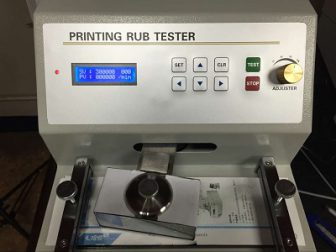Ink Abrasion Color Fastness is designed to measure scuffing or rubbing resistance. Several tests can be performed including dry rub(the amount of transfer ink from one dry surface to another), wet rub(the amount of transfer of ink from wetted surface to another), wet bleed or transfer (ink transfer to a water-saturated blotter), wet smear(similar to wet bleed with the addition or rub cycles), functional rub/wet rub(smear or transfer tests using a liquid other than water), and hot abrasion.

The test specimen is removed from the qinsun-lab base and examined for degree of print degradation. The receptor is analyzed for the amount of ink transferred from the specimen.Results are compared to an agreed upon standard sample tested in the identical fashion.
Ink Rub Test Procedure:
Obtain a 152 x 76 mm (6 x 3 in.) printed sample, representative of the run in ink-lay and coverage. When the printed
area permits, the longer direction should be cut across the grain of the sheet, but must not cross scores. Unprinted stock
from the same run should be provided in 152 x 51 mm (6 x 2 in.) sizes (for dry rub and wet rub). In both cases, cut the
longer dimension across the grain of the board.
Dry rub.Clip a 152 x 51 mm (6 x 2 in.) unprinted specimen to the 1.8-kg (4-lb) test block, with the
printing surface away from the rubber pads. Place the printed sample, print side up, on the rubber pad of the base plate.
Place the weight over the sample, and make sure that both surfaces are free of dirt. Preset the tester for ten strokes by referring to the chart below the automatic timer.
When the rubs have been completed, examine both the inked surface and the plain surface on the test block for signs
of transfer. Repeat the ten stroke sequence until transfer occurs or a predetermined limit is r
eached. The two test strips
should be stapled together and used for visual reference and interpretation. They should be marked plainly with the
number of rubs given.
Wet rub.Mount the strips in the same manner as for dry rubs, using the 0.9-kg (2-lb) or 1.8-kg (4-lb)
test block. Preset the tester for one rub. Place three to six drops of water on the printed surface so that they will be
covered by the test block. Place the block in position and immediately press the start button. After one stroke, examine
both surfaces for color transfer. Repeat single strokes until ink failure is noted or the surface of the board shows fuzz
or abrasion. This same test can also be used to determine the wet rub of unprinted surfaces.
Wet bleed or transfer.Make a strip of blotting paper or cotton cloth (see TAPPI T 205 “Forming
handsheets for physical tests of pulp”) 152 x 51 mm (6 x 2 in.) on the 0.9 kg (2-lb) or 1.8 kg (4-lb) test block with the
felt or smooth side out and saturate the blotter or cotton cloth with water (an eyedropper is convenient).
Place the wet blotter or cotton cloth on the sample to be tested and leave it in place for 4 min. Remove the block
without rubbing, and examine for ink transfer to the blotter or cotton cloth. The same blotter or cotton cloth may be used
for checking wet smear.
Wet smear.Return the wet-bleed block and blotter to the inked sample and actuate the tester for one
stroke. Examine the blotter for color transfer. (The notation of wet bleed should also be recorded on this sample).
Functional rub.Functional rub is a term embracing a number of miscellaneous uses for the Sutherland
rub tester. An ink which is acceptable under the outlined test procedures may fail in use as a result of exposure to other
liquids or pastes. For example, certain inks might be tested to conform to specifications such as “one rub, cod liver oil”
or “three rubs, Jones Antacid Toothpaste.” Functional tests are limited only by the ingenuity of the operator and the
many uses being found for printed paper or paperboard surfaces. In reporting functional rubs, the operator should specify
the number of rubs, the time of contact before rubbing, and the special conditions and testing mediums employed.